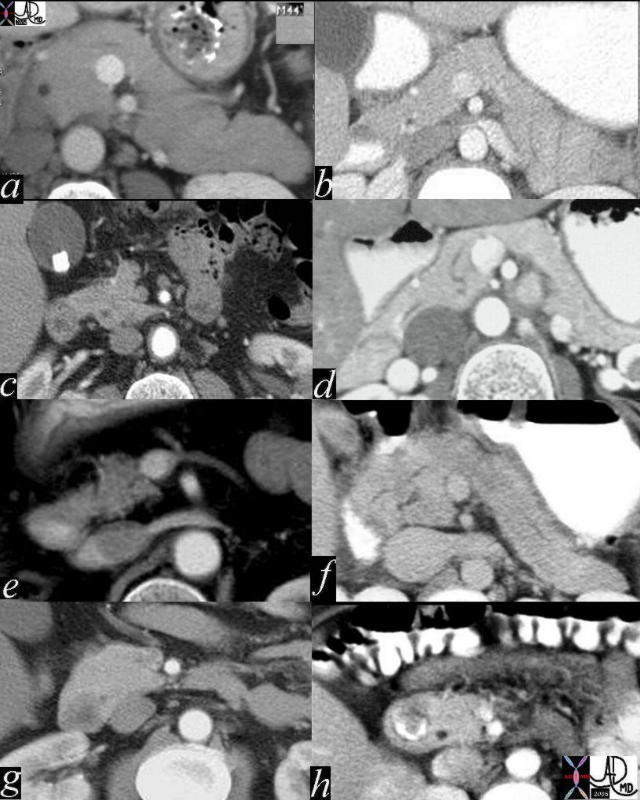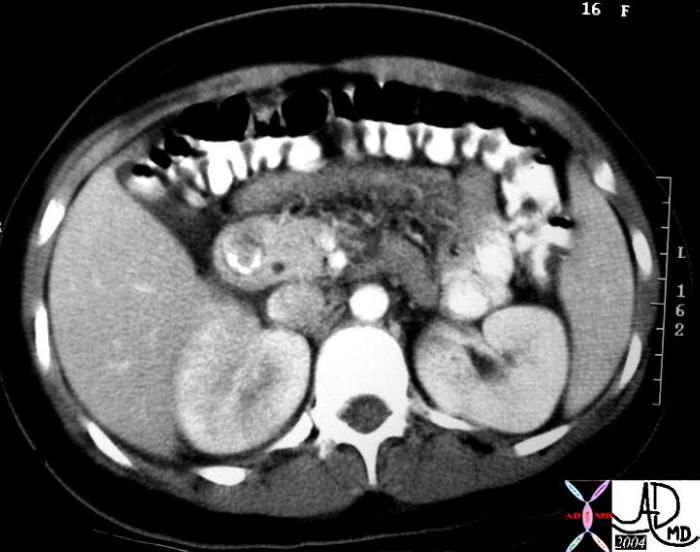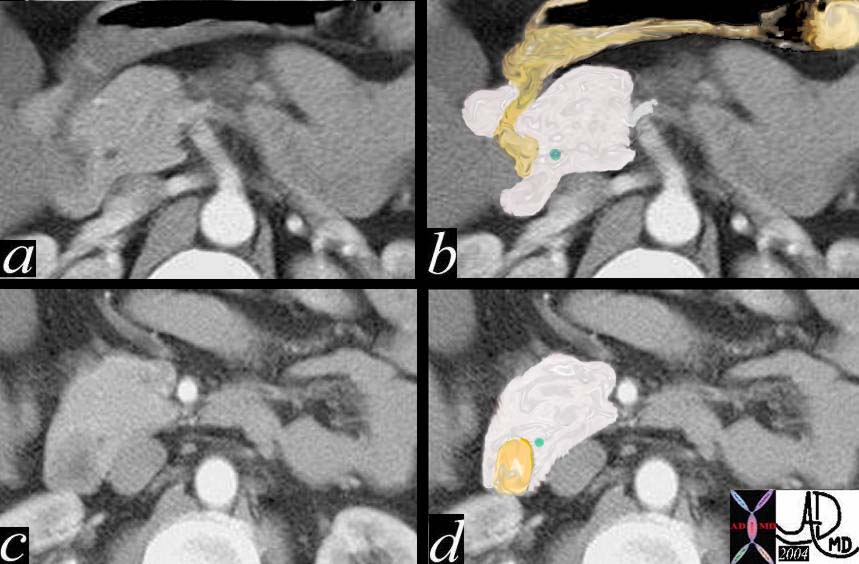|
The Common Vein Copyright 2007
Ashley Davidoff MD
Introduction
Embryological basis – Dual Origins
Embryologically, the pancreas forms from a ventral anlage that becomes the inferior pancreatic head and uncinate process and from a dorsal anlage that becomes the superior pancreatic head and the body and tail of the pancreas. The fusion of ventrql and dorsal portions occurs at about 6-8 weeks of gestation.
The pancreas arises from two separate endodermal outpouchings from the distal portion of the foregut. These outpouchings originate from opposite sides of the developing duodenum with the ventral portion forming the anlage of the liver, biliary tree, and inferior aspect of the head and uncinate process, while the dorsal anlage grows into the dorsal mesentery to become the tail, body neck and superior portion of the head of the pancreas.
The ventral anlage, in concert with the biliary duct, has to rotate in clockwise fashion around the duodenum in order to enable fusion with the developing dorsal anlage. The fusion occurs between six and eight weeks of pregnancy. While the fusion of parenchyma seems to be seamless, the fusion of the respective ductal systems is more complex and results in a variety of morphogical complexes.
The usual result of the fusion is a minor duct that drains the superior aspect of the head and a major duct that drains threst of the pancreas.
The portion of the dorsal duct that had formerly drained the head of the pancreas becomes the minor duct of Santorini and it drains the superior portion of the head and enters the duodenum about 1-2cms cranial to the papilla. The major pancreatic duct of Wirsung is composed of the the dorsal duct subtending the tail and the body and the ventral duct draining the inferior portion of the head and uncinate. The relationship of the ventral potion of the pancreatic duct and the the common bile duct remains constant and the junction forms the ampulla which terminates in the papilla within the mid portion of the descending duodenum.
In annular pancreas the rotation, resorptive , and fusion process of the normal development fails and an annular ring around the pancreas remains. This may be asymptomaticxc or may cause duodenal obstruction.
 The ventral remnant has a variable shape as it relates to the duodenum. It is mostly an inverted “c” and occupies about 1/3 to 1/4 of the circumference. (a-f). Sometimes it partially or totally surrounds the duodenum resulting in the entity of annular pancreas (h) 41505c02 Courtesy Ashley Davidoff MD The ventral remnant has a variable shape as it relates to the duodenum. It is mostly an inverted “c” and occupies about 1/3 to 1/4 of the circumference. (a-f). Sometimes it partially or totally surrounds the duodenum resulting in the entity of annular pancreas (h) 41505c02 Courtesy Ashley Davidoff MD
Anular pancreas
 In this cross sectional image of the pancreas the ventral portion of the pancreas totally surrounds the duodenum but does not cause obstruction. This is a case of annular pancreas. 30906a04 Courtesy Ashley Davidoff MD In this cross sectional image of the pancreas the ventral portion of the pancreas totally surrounds the duodenum but does not cause obstruction. This is a case of annular pancreas. 30906a04 Courtesy Ashley Davidoff MD
 This is a CT scan through the pancreas where there is only a partial divisum anomaly. Images a and c are two different levels showing almost 70% encirclement of the pancreas (pink) around the duodenum (d orange). Courtesy Ashley Davidoff MD 18090c06 This is a CT scan through the pancreas where there is only a partial divisum anomaly. Images a and c are two different levels showing almost 70% encirclement of the pancreas (pink) around the duodenum (d orange). Courtesy Ashley Davidoff MD 18090c06
|

 The ventral remnant has a variable shape as it relates to the duodenum. It is mostly an inverted “c” and occupies about 1/3 to 1/4 of the circumference. (a-f). Sometimes it partially or totally surrounds the duodenum resulting in the entity of annular pancreas (h) 41505c02 Courtesy Ashley Davidoff MD
The ventral remnant has a variable shape as it relates to the duodenum. It is mostly an inverted “c” and occupies about 1/3 to 1/4 of the circumference. (a-f). Sometimes it partially or totally surrounds the duodenum resulting in the entity of annular pancreas (h) 41505c02 Courtesy Ashley Davidoff MD In this cross sectional image of the pancreas the ventral portion of the pancreas totally surrounds the duodenum but does not cause obstruction. This is a case of annular pancreas. 30906a04 Courtesy Ashley Davidoff MD
In this cross sectional image of the pancreas the ventral portion of the pancreas totally surrounds the duodenum but does not cause obstruction. This is a case of annular pancreas. 30906a04 Courtesy Ashley Davidoff MD This is a CT scan through the pancreas where there is only a partial divisum anomaly. Images a and c are two different levels showing almost 70% encirclement of the pancreas (pink) around the duodenum (d orange). Courtesy Ashley Davidoff MD 18090c06
This is a CT scan through the pancreas where there is only a partial divisum anomaly. Images a and c are two different levels showing almost 70% encirclement of the pancreas (pink) around the duodenum (d orange). Courtesy Ashley Davidoff MD 18090c06